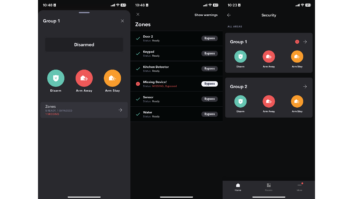
Remember the feeling of freedom you got when you plugged in your first wireless router? You could finally take your laptop off the desk, and use it from the sofa, the kitchen…even while tucked into bed. What liberation!
With just one or two devices connecting to the network, these early solutions worked great. But then came burden after burden: first smartphones, then tablets, then TVs. With most households now having multiple wireless devices connecting to the home network, these once-great configurations have become simply good enough–at least for now.
But for today’s connected home, a traditional wireless network is far from adequate. When everything from door locks, to lights and shades, security systems, and AppleTVs are reliant on a strong, steady stream of Wi-Fi, a simple little black box with antennas just can’t cut it.
“In a regular home, without an automation system, network hardware malfunctions and internet outages usually translate to mild frustration, a router reboot and ultimately a replacement of said router,” said Hagai Feiner, founder and CEO of Access Networks. “In an automated home these issues mean everything stops. An automated home cannot function without a reliable networking solution.”
When Feiner launched Access Networks in 2003, the connected home as it exists today was still a ways off. Still, there was a strong demand for robust networks from Los Angeles-area corporate clients that wanted their homes to have the same enterprise-grade networks as their offices. By 2010, when the amount of connected devices in homes really began to balloon, his company was already in a great position, with a national dealer base and hundreds of accounts.
“In the last decade, the growing number of wireless devices in the automated home, and an attuned desire for uninterrupted wireless connectivity, has changed the landscape of the home network,” Feiner said. “The need for an enterprise-grade networking solution in the modern home has become an absolute essential.”
To respond to this need, especially with the advent of AV/IT convergence and the nascent Internet of Things (IoT) revolution, his company provides residential clients with custom-tailored, pre-programmed networks using the latest hardware from Cisco Systems and Ruckus Wireless. These systems are designed, he said, to meet the requirements of today’s connected environments, as well as those to come in the future.

Hagai Feiner, Access Networks founder and CEO Luxul is another company that has thrived on the expanding need for residential connectivity. Like Access Networks, Luxul has been supplying the custom integration industry with professional-grade IP networking solutions for use both in the home and the office. According to Brannon Young, director of technical sales, the popularization of AV/IT has been very helpful to Luxul’s business.
“AV integrators are not historically IT experts, so they look to manufacturers that can give them the products and training they need to be successful,” he said. “Luxul puts a lot of emphasis on providing dealers with training and education to help them be successful, which has resulted in growth for Luxul.” To further capitalize on this AV/IT trend, the company has even designed a line of switchers and routers specifically with AV environments in mind.
Like Luxul, Pakedge was also quick to get in the door to capitalize on AV/IT. “It was difficult early on for AV installers to understand how the internet was changing the business,” said Benson Chan, vice president of business development. “Pakedge saw this as an opportunity early on, and we helped carve this niche of network devices and platforms that are designed specifically for AV/IT convergence. We’ve been very successful and proud to be considered leaders in our field.
Like with anything, increased popularity brings increased competition. New companies are getting into the networking game, and established companies and service providers are offering “business-class” solutions. But with these solutions, Feiner said, users can’t be sure of the level of support they will receive after the installation.
“Our true enterprise-grade networking equipment is completely visible,” he said.
“By visible, we mean that our team of certified IT professionals is able to see a detailed log of the network’s activity, troubleshoot remotely, and resolve any issues that may arise. Our three-year support warranty ensures our clients are connected at all times and immediately taken care of should a network disruption occur.”
For companies like ihiji, the concept of “visibility” is at the very heart of their business. ihiji specializes in remote management of IP-enabled devices, ensuring that the multitude of connected IoT devices are working properly.

Benson Chan, Pakedge VP of business development “The important advantage is that network managers can be notified whenever device statuses change, or certain device thresholds are met,” said Steve Muccini, director of marketing at ihiji. “Gaining access to this information can be the difference between catching and rectifying network and devices issues and having the network and devices go down, leading to irate customers. In addition, if the network manager happens to be offsite, running ihiji remote network management services allow them to dramatically reduce their support costs by eliminating the need to roll a truck.”
Managed services is also an area where Pakedge is looking to expand. “Today’s networks are Frankenstein monsters–a mix and match of technologies from different vendors,” Chan said. “Often, AV networks are overly complex and pieced together with hardware and software from various manufacturers. This results in tedious setup processes, functional redundancies, and reduced network efficiency.” To increase efficiency in this area, the company is developing the Connect+ Platform, to ease network installation and management, and optimize performance.
So what does the future look like for the home network? “Over the next five years, the home network is really going to be about getting more bandwidth to support the rise of the smart home,” Young said. “With the emergence of IoT devices like thermostats, smoke detectors, motion detectors, security devices, door locks and so forth, not to mention 4K video, more streaming content, more mobile devices, etc., the home network–specifically the wireless home network–is going to become even more bandwidth driven.”
Feiner agrees, and he believes this expanding ecosystem will provide a steady supply of opportunities for integrators. “Chances are, if an enterprise-grade network was installed in a home five to six years ago, it would be running smoothly, but using older Wi-Fi and ethernet standards,” he said. “As a result, retrofit work will become a key business component for integrators. The bottom line here is that there is a significant profit opportunity in home network upgrades.”
Whether or not every appliance in our homes is IoT-enabled in five years, as some imagine–Feiner predicts that our refrigerators will be automatically ordering milk from Amazon–it’s certain that the demand for connectivity will grow tremendously in the near future. By installing a robust, intelligently managed network in your clients’ homes now, you can help them both transform the reliability of their entertainment and security systems now, as well as lay a foundation for all of the new and exciting developments to come.
Matt Pruznick ([email protected]) is the associate editor of Residential Systems and Systems Contractor News.







